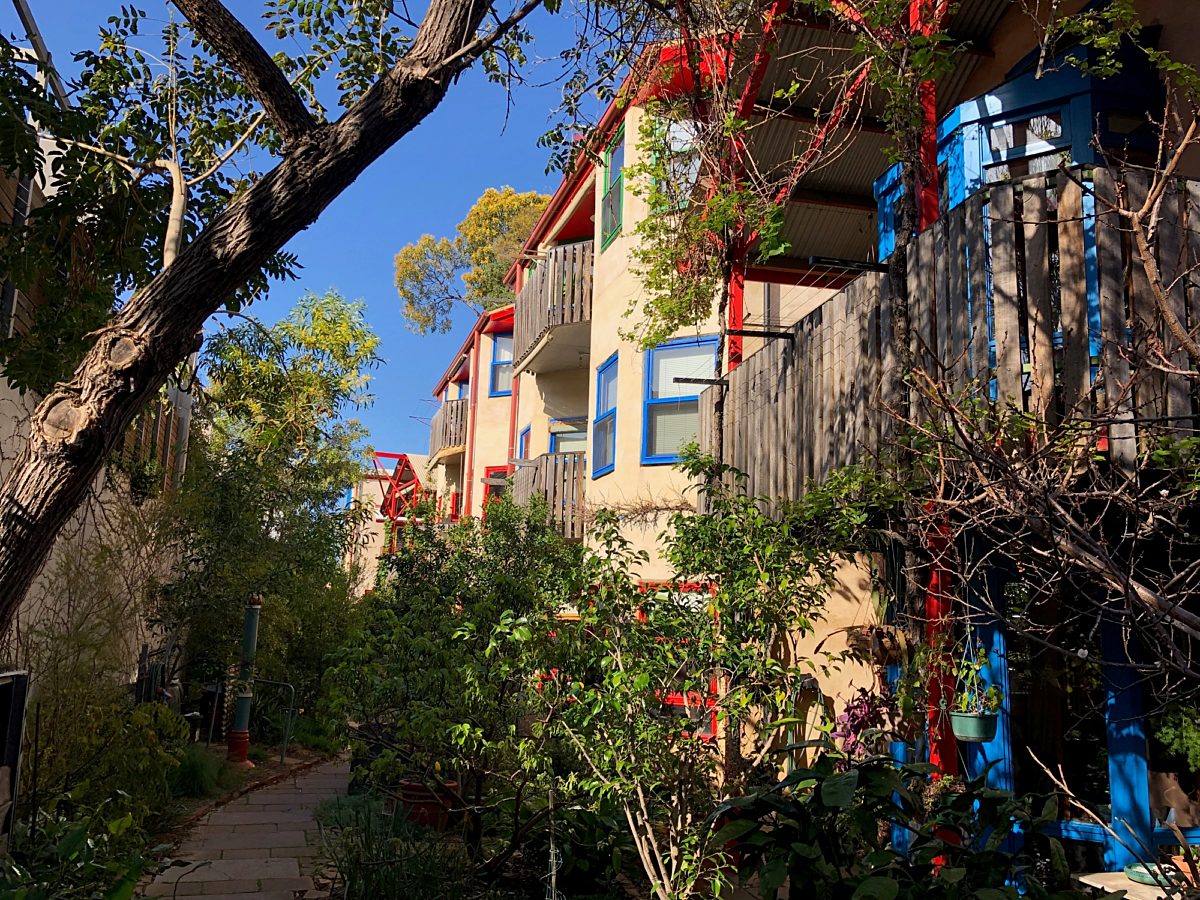Sustainability alive and well two decades on at Christie Walk
“It’s been quite the adventure”, says Brian Loffler when asked to describe the evolution of Christie Walk, the thriving eco-community in the heart of Adelaide which continues to draw visitors and international praise twenty years after its creation.
Initiated by Urban Ecology Australia in 1999 as a demonstration project, Christie Walk is home to 40 residents just south of the Adelaide Central Market. The 27 low-impact apartments and townhouses provide affordable environmentally-conscious living on a half-acre site in the heart of the city. Solar power, smart, natural heating and cooling, good insulation and large-scale rainwater storage are among the initiates that transformed what was once the site of a Council recycling facility, into an award-winning showcase and great place to live.
Today, 91% of the community’s energy needs is generated on site and through an ongoing focus on minimising the carbon footprint, right now annual CO2 emissions are around 1 tonne per resident, an impressively low output for what is – but doesn’t feel like – high-density living. For comparison, the national greenhouse inventory says the average greenhouse emissions per person in 2019 was around 21 tonnes CO2.

Resident and a recently retired engineer and planner who leads the sustainability activities at Christie Walk, Brian describes the moment when the land was acquired and the vision drew a step closer.
“I can well remember sitting down on the bare block of land trying to envisage what we could do as a community,” Brian said. “We were fortunate to have architect Paul Downton involved from the start. He lived here for the first 5 or 6 years before moving to Melbourne. He’s been one of the key leaders of the Eco-City Movement. Paul would say the city can save us in terms of climate change. Because cities are renewed every 20, 30, 40 years through development and rebuilding, there are huge opportunities to make the urban development more sustainable.”
Thoughtful planning gives residents both privacy and community. Meandering paths, a rooftop kitchen garden and a monthly working bee and community meal mean the people who live at Christie Walk are frequently in contact with each other.
Residents also describe the shared laundry as a meeting spot, and the quiet stream of bikes in and out of Christie walk which has 30 bike spaces on site.
Key to driving the sustainability agenda forward at Christie Walk is its ‘Green Fund’, a legacy of the founding residents who agreed income from initiatives such as solar panel rebates would be redirected to finance future upgrades rather than offsetting living expenses. As you might expect, the process of deciding how accumulated funds is spent, is a collaborative one.
“One of the things when preparing proposals for approval is to circulate them first to a small works and maintenance committee. I see what questions and suggestions they have and then put together a set of Q&As for residents,” said Brian. “It’s quite a process of keeping people informed about what we are thinking about with future green projects and to keep people moving along. The enthusiasm is there but there is always work in explaining the effectiveness and efficiency of technology.”
“Just about every day, someone is stirring the compost and we have a roster to make sure the plants in the main plaza are watered. Others will be working in the kitchen garden – planting and picking fruit and vegetables. We also have two large beehives on the rooftop garden and we share the honey. Paul designed it cleverly, so as you’re going about the day you inevitably bump into others along the way. Every now and again someone says they’ve got a bottle of wine, and we catch up.”
Upgrades in the past 3 years include switching to LED lighting, installing a new high-efficiency 21kW solar photovoltaic system, and installing time clocks and insulation blankets to heat-pump hot water systems. Rather than replacing the ageing heat-pump hot water system with a new solar hot water system, the community opted for the less expensive solution of installing evacuated tube solar hot water collectors as boosters. The two banks of collectors are mounted at different angles to capture the summer and winter sun – 30 degrees and 45 degrees respectively. The Tesla battery installed last September finishes charging itself by lunchtime and provides power to 13 apartments until around 10.30 or 11 at night. All these upgrades were financed through the Green Fund.
Christie Walk is sitting at around 70% towards its goal of achieving Net Zero Carbon Efficiency. The community hopes to install another battery in the coming year and is currently exploring which technology – block-chain, smart-meter or central controlling device – could best allow electricity generated from the sun across more dwellings.
“We’ve learned we can’t sit on our laurels; keep pushing ahead. Even with all the projects we’ve done so far, there is still more we can do,” said Brian. “It’s all about collaboration and teamwork. It’s such a beautiful place to live and it’s part of our ethos to be an educational outreach body to show people who are interested what can be achieved.”
Tours of the Christie Walk Ecocity are available for students and the general public and are led by guides who are well-versed on technical and social aspects of community life. Learn more at https://www.urbanecology.org.au/get-involved/book-a-site-visit/.
Brian has also written a detailed series of articles about the technologies employed at Christie Walk from 2017 – 2021, full of information on the practicalities of being a green community.
